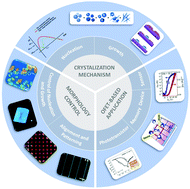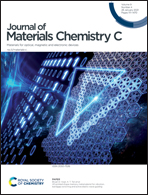Solution-processed organic semiconductor crystals for field-effect transistors: from crystallization mechanism towards morphology control
Abstract
Organic semiconductor crystals are promising candidates for high performances due to their long-range order, absence of grain boundaries, and minimal traps and defects. Among the preparation methods, solution processing techniques have been widely concerned due to their advantages of high efficiency, low cost, and large area preparation. In order to achieve high-quality single crystals or crystalline thin films, morphology control during crystallization is critical. Generally, morphology regulation is based on the crystallization process of organic molecules in solution, including nucleation and crystal growth. Therefore, the crystallization mechanism on the morphology regulation of organic semiconductor crystals should be considered systematically. In this review, we summarize the recent progress in the crystallization mechanisms of organic semiconductor crystals, the morphology control strategies associated with the crystallization behaviors, as well as the field-effect transistor (FET)-related device applications,which will be of significance for morphology regulation of organic materials toward high-performance devices.



 Please wait while we load your content...
Please wait while we load your content...